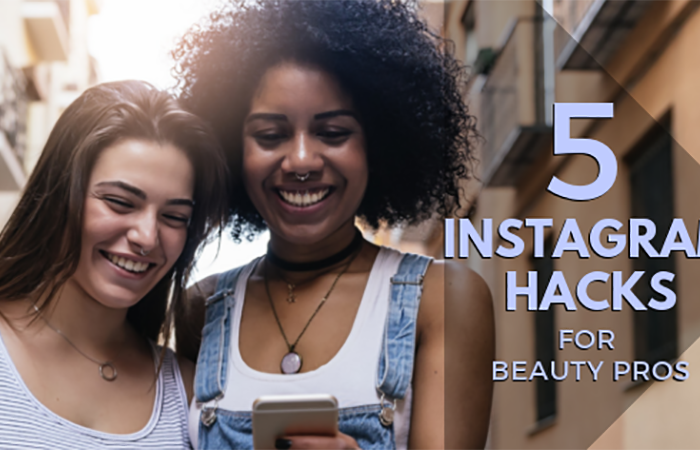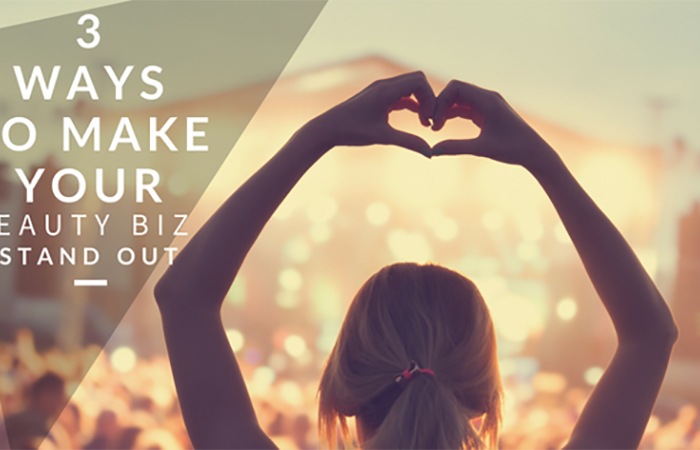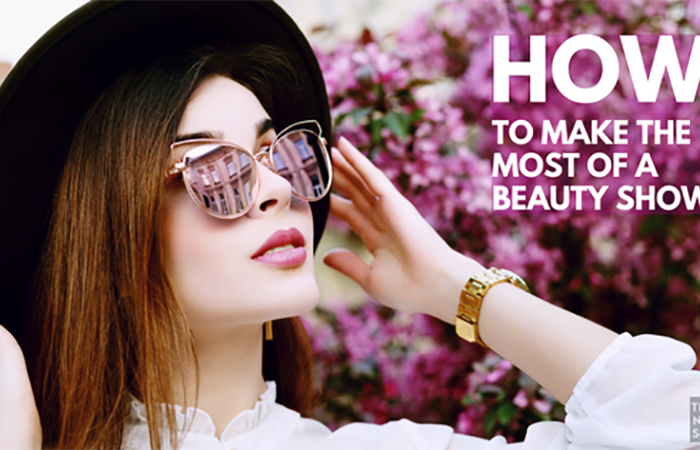Since we’ve been back from New York, we’ve been compiling content from fashion week; getting photos and posts together in an attempt to share what we saw and experienced backstage. Everything that we’ve shared so far has come with comments from nail techs that are wistfully wishing to be working at NYFW one day, and asking how they can make that happen. 10 THINGS YOU NEED TO KNOW TO WORK FASHION WEEK
The prevailing attitude in the world is that fashion week is a semi-annual event that is the pinnacle of glamour; fashion editors and bloggers stepping out of black Lexus SUVs, past screaming throngs of paparazzi, and into their seats at the front row of their favorite designers. Jackets dance over shoulders, and air kisses abound, while the well-heeled flit from venue to venue. While this is generally true, those artists working backstage can have a very different experience.
Those not working backstage at fashion week feel that the glamour and excitement must be shared from front of house to back. If you’re working a show, you probably sip bottled water and take selfies with the famous models, the designer, and then all go watch the show together, right?
Not so much.
If you’re really serious about working backstage for fashion week in any of the cities where the shows happen, we have compiled a guide of the ten things you must know in order to do it effectively. While many of these points can apply to almost any job backstage, (makeup, hair, dressing, etc.) we’ll be focusing on manicuring.
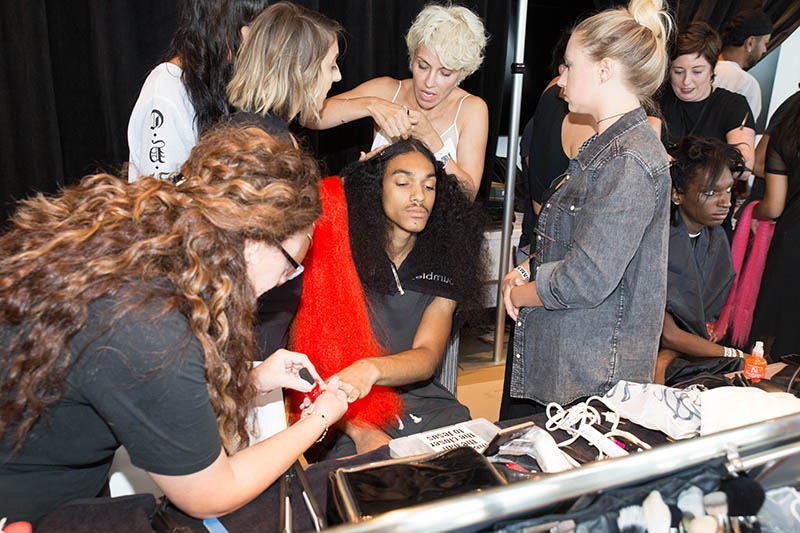
Danalynn Stockwood working hard amid backstage chaos
1. This is not glamorous work
There are three fundamentals that you will need to understand when considering backstage work; You will sweat, you will probably cry, and you will get stepped on. This post is not meant to discourage anyone from working backstage at fashion week, but only to help those who are interested to have a realistic expectation.
As a member of the nail team, you will generally have to report to the venue anywhere from two to three hours before the show is scheduled to walk the runway. This can mean 6:00am call times at a venue across town, so you wake up at 4:00am. You figure out which train you need to take to get there on time (punctuality is crucial) and if you’re lucky, you have time to grab a quick coffee on the way in to the venue.
In any given show, there are anywhere from seven to 45 models whose nails need to be completed. Add hairstylists, makeup artists, photographers, videographers, press, and the designer’s team, you have a lot of people in a confined space. Everyone has a job to do in a limited amount of time, and everyone is on top of each other. It is not a place for high heels, dresses, low cut tops, or large amounts of jewelry. You’ll likely wear a branded t-shirt or be asked to wear all black. Dress for comfort, but dress professionally.
2. There is a hierarchy
On every show’s team, there is a hierarchy. Every show has a lead manicurist. The lead manicurist is the one who has worked with the designer to determine the look during a beauty test. The beauty test is generally the week of the show, (but can be months before) and the designer and their team meets with the leads for hair, makeup, and nails, along with a stylist, to determine the final beauty looks for the show.
It is at this meeting that the lead manicurist decides if he/she will be making nail tips ahead of time, or painting the look(s) directly onto the models. The designs and colors are finalized, and the lead prepares for the show by confirming the team, ensuring they have enough nail techs to complete the number of expected models within the time frame allocated.
As a member of the nail team, you are responsible for recreating the lead’s vision EXACTLY on every model. The looks can vary, or be a single look across all hands or feet. And did we mention that there may be pedicures too?
You’ll want to avoid working on the model in the lead hairstylist or makeup artist’s chair, as they are generally demonstrating the look for their respective teams. You’ll know who the lead is, as they are usually surrounded by cameras and PR people.
3. Follow the lead
The lead manicurist is the captain of the team. Listen to their instructions, and work quickly, but accurately. The lead will likely be speaking to press that arrives at the show, and will check the work of the manicurists working under them. They may ask you to redo something you’ve done on a model, ask you to change how you’re doing something, or change your focus from manicures to pedicures, etc.
Take the feedback in stride, and use it as a learning opportunity to make you a better backstage manicurist. This is not the time to ask a million questions or start a conversation about technique. Listen carefully to the instructions you’ve been given, and change courses immediately if asked to.
4. Be prepared for anything
Packing a backstage kit that includes items for any scenario is a great way to be asked back for future shows. Bring remover in a pump-top bottle, alcohol, multiple types of files, lint-free wipes, clippers, nippers, hand sanitizer, hand cream/lotion, cuticle remover, nail glue, nail glue tabs, small scissors, tweezers, nail art brushes, cuticle oil, base and top coat, quick dry spray or drops, polish thinner, a small lint-free or microfiber towel, nitrile gloves, pedicure sandals, empty tip box, and then add a small first aid kit, a bottle of water, mints, a small foldable step stool, a head lamp, and an open-top set bag to put it all inside of that is portable and small enough to take from model to model.
As we stated earlier, plans can change at a moment’s notice, and you never know what you may need, or be asked of, backstage. We’ve only worked three seasons at New York fashion week, and we’ve seen models with gel polish on hands and feet, grown out enhancements, and have been asked to give the designer a quick manicure touch up since we happened to have stocked kits.
Some lead manicurists will ask you to bring additional items for your kits, and they will provide you with the color products you need to complete the look from the sponsor brand. It is important to remember that only the sponsor’s products should be included in photographs, so hold the product in your hand label side out, as photographers will be moving around the room taking photos of the nail team working.
5. Get comfortable being uncomfortable
If you are used to seeing clients in an environment where everything is controlled, from the height of your table to the position of your clients’ hand, get ready to be outside of your comfort zone backstage. You will generally be working on a model who is also being worked on by a hair stylist or makeup artist. The model will probably not be paying attention to what you’re doing, and will have his/her phone in their other hand. You’ll be under a table, or between multiple people standing over you. The lighting can vary greatly, so you’ll be prepared with a head lamp or some other form of portable lighting.
This is where you’ll likely be stepped on, (or kicked!) There is a fine line between being a wallflower and taking the space you need to complete your job. This is where you’ll need to be diplomatic and work with the other artist you’re sharing a model with to find a good arrangement. Keep in mind that everyone is on the same team at the end of the day, which is to get the models completed and out to the runway. Keep your cool and remember that it is all in the name of fashion.
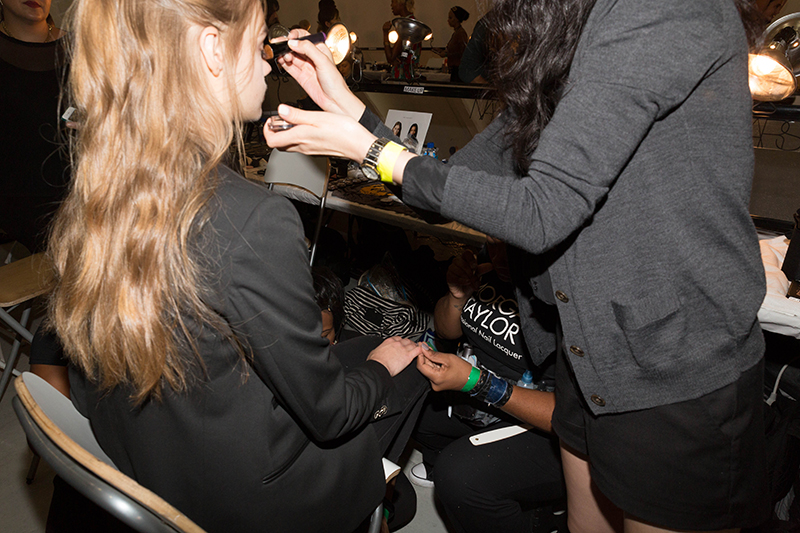
Can you spot the three nail techs in this picture?
6. Plans will change – be adaptable
The look can change at a moment’s notice, or there may be an issue with the pre-made tips, or a model may be coming in late from another show, or there may be 20 more models than you had planned for! Keep your head down and work quickly. If you’re prepared for the unexpected, and have the right attitude about being adaptable, everything will go well.
7. Stay organized
You may be given several sets of pre-made tips, accessories, or special tools to complete a given look. It is imperative to keep track of those items as you move from model to model. Losing tips, spilling tips, or leaving tools behind is a huge no-no. As you complete nails on models, you also need to keep track of the models’ names so that the backstage coordinator or lead manicurist can mark them as completed.
Keeping a small notepad in your kit bag or notes on your phone is a great way to remember names between check-ins with the lead. There is frankly no excuse for not getting or not remembering model names since that is how completion percentage is measured.
8. Have the skills you advertise
This isn’t a Joey Tribbiani situation; you actually have to have the skills listed on your resumé. If you haven’t worked backstage before, don’t say that you have. You can, however, list your relevant experience in working in a busy salon, or working on local fashion shows or photoshoots.
Having major skills working with traditional polish is a pre-requisite. Being able to polish with a thin, clean, application is the most valuable skill set when working backstage. Nail art proficiency is great too, as you’ll need a strong ability to freehand half moons, geometric shapes, and a killer french tip. Ability to work with full cover tips is essential, as you will need to know how to file tips into natural looking shapes on the models’ hands.
The time to practice these skills is NOW, if you want to work next season (February.) Start polishing every hand you can find, especially those that aren’t quite ready for their “close up.” Perfect a clean application and then begin working on your timing. Ideally, you shouldn’t spend more than 10 minutes per model, 15 if there are feet involved. Perfect and fast, is what is required at fashion week.
9. Be a team player
We’ve all been there. You forgot a specific implement, or someone borrowed something and didn’t put it back. If you find yourself or a teammate in that situation, share! Again, remember that everyone is on the same team, working towards the goal of getting the models completed and out the door.
Another aspect of being a team player is staying focused and working quickly. It isn’t fair to the rest of the team that you only did two models and everyone else did seven in the same amount of time. Working as a team means grabbing a foot to file off the gel polish that a model had applied at the last show, and going to town (true story.) It also means ensuring that the lead looks great when the models walk the runway by completing stellar work as a team.
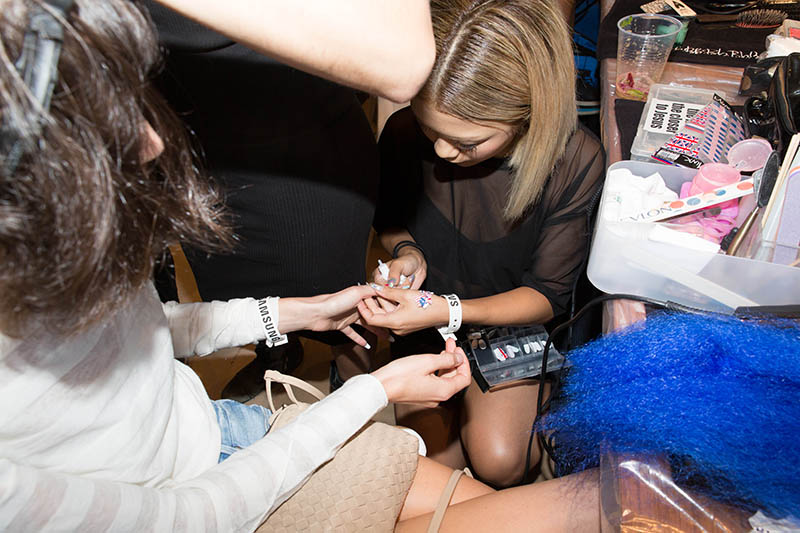
Carving out a workspace backstage
10. Mind your (social) manners
The chief rule for during and after show etiquette is to mind your manners. The lead will generally send you an agreement or rules for backstage before the show, or if it is your first time working on their team. They will direct you when and if you can take photos, and if you can take breaks or grab food or drink from the tables backstage. Be professional with everyone you come into contact with backstage, no matter their role. Even when there is ego flying around the room, just complete your work and be the professional. 10 THINGS YOU NEED TO KNOW TO WORK FASHION WEEK
The biggest rule about social media is not to claim the lead’s work as your own. If you post an image from the show, make sure it is clear that the lead manicurist’s design and vision is credited. Captioning a photo “my work for XYZ show” is a surefire way not to get asked back for the next season.
So those are the 10 things you MUST know to work backstage at a fashion week. There are probably many, many more things that you’ll learn along the way, with experience. We LOVE being backstage with the nail teams to see the camaraderie, the successes, and the killer nail looks created by those teams.
We know that this isn’t an all-encompassing list, so we asked some industry leaders for their advice about their experience working behind the scenes:
“Show initiative, be a team player, WANT to be a team member, not an individual contributor backstage. Follow direction…if the lead says credit all photos, then credit all photos. Once I see a post of nails I designed for NYFW on someone else’s IG captioned “Nails I did for NYFW,” sadly, they won’t be asked back.
A LOT goes into creating and maintaining the relationships with designers & the sponsors I use. However, those that show initiative, the go-getters, the ones volunteering to prep, offering to pick up supplies, etc… are those that will be called upon one day when I need to pass a show on! I am pretty sure it can all be summed up in one word…professionalism.
Practice polish perfection & timing skills NOW, and learn how to apply tip so they look natural, even if that means filing down a size 2 tip to fit a size 10 nail!”
“Working at Fashion week had always been a career goal. It was such a treat to see and experience everything that happens behind the scene from shaping nail tips to seeing my work walk the runway. It is a tremendous amount of work to pull together something this spectacular and I am lucky and grateful to have witnessed the elite CND team at work. These are definitely moments I will treasure for the rest of my life! Oh, and stay hydrated.”
“The things I wish I knew before working backstage are to always be prepared, plans will ALWAYS change and how exhausting working shows can be. I make sure I have two of everything and extra items which even aren’t on the list of what the lead nail artist suggests. Band-aids, a clean up brush, and baby wipes always come in handy. Also packing water, and quick snacks are important to have so you can stay hydrated and curb hunger.
Plans are ALWAYS changing, from call times, to model quantities, to where you are needed. There will be times when you will be needed a bit earlier or later, so be flexible. Be prepared to have everything needed to cater to additional models, even if there are four nail techs working on one model. Team work is VITAL! Sometimes the nail lead might need you at a different show to help out. Remember you are there to assist the nail lead, not vice versa. Fashion week is EXHAUSTING!! Rushing to get models done, working in confined spaces, lack of beverages/food, early call times and traveling in NY. Factors which lead to the exhaustion. However, would i do it again? Most definitely. Why? Because EVERY show has amazing energy, EVERY lead directs differently, EVERY experience is phenominal and so memorable.”
“I wish I would have known you will always leave smelling of stinky model feet on a Spring season, that you WILL get stepped on by camera men/women, and that it is very helpful to have some sort of head lighting situation for you will be working on the ground under tables under makeup artist/hairstylist.”
10 THINGS YOU NEED TO KNOW TO WORK FASHION WEEK

